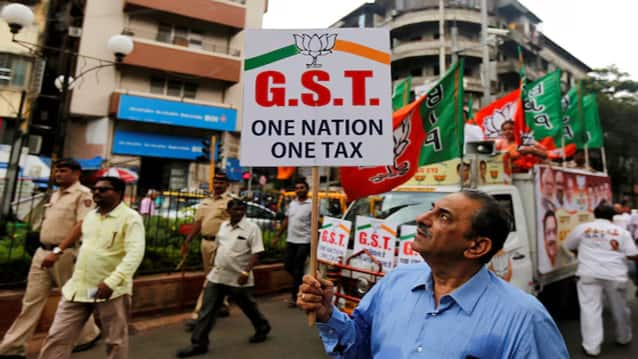By reducing complexity, the reform strengthens India’s case as an investment destination and improves its ease of doing business scenario.

Globally, the move aligns India closer to VAT models in Europe and Asia that run a single standard rate, complemented by one or two reduced rates. (Source: reuters)
When India introduced the Goods and Services Tax (GST) in July 2017, it was hailed as a “Good and Simple Tax” that would unify the country’s complex indirect tax landscape. Yet, over the past eight years, businesses, particularly small ones, have often found it anything but simple. A four-slab structure, numerous exemptions, and inverted duty chains created both compliance headaches and liquidity stress.
On Wednesday night, the GST Council attempted its boldest course correction yet. In a decision expected to reshape consumption patterns, industry dynamics, and state revenues, the Council collapsed the four tax slabs into a two-tier structure. The new framework introduces a merit rate of 5 per cent, a standard rate of 18 per cent, and a de-merit rate of 40 per cent reserved for sin and luxury goods. The changes, effective September 22, aim to simplify compliance, spur consumption, and restore GST’s original promise.
The New Rate Architecture
The restructured GST leaves behind the earlier 5 per cent, 12 per cent, 18 per cent, and 28 per cent slabs that often confused businesses and consumers alike. Now, most essential and semi-essential goods ranging from soaps, shampoos and biscuits to chocolates and ready-to-eat items will attract the 5 per cent rate. Industrial goods, durables, cement, tractors, automobiles, and most services will fall in the 18 per cent bracket. Luxury items, tobacco products, pan masala, aerated beverages, and high-end cars will be taxed at 40 per cent.
Also read: Convergence: The Catalyst for Entrepreneurship and Growth
Significantly, the Council has exempted life and health insurance premiums, as well as a number of life-saving drugs and critical medical devices. This directly lightens household budgets while addressing healthcare affordability, a politically and socially sensitive sector.
By pruning slabs and recategorising goods, policymakers hope to deliver a cleaner tax architecture that aligns with global practices, where most countries run one or two GST/VAT rates.
Simplification Strategy
The immediate goal of the reform appears to be simplicity. For smaller firms, compliance was disproportionately costly under the old system. Many micro and small units spent heavily on consultants to manage classification disputes, input tax credit (ITC) claims, and filing errors. The rationalisation now is expected to reduce these frictions.
For many in the Industry, there are direct gains. “When consumption increases, many goods that are produced at the MSME level will also see higher demand. This will benefit them as their business will grow. On the other hand, with the creation of two slabs, the compliance burden on MSMEs will be greatly reduced,” said Manish Singhal, Secretary General, ASSOCHAM.
The GST Network (GSTN), the digital backbone for compliance, also benefits from a simplified structure. Fewer slabs mean fewer disputes, faster processing, and potentially smoother refunds, an area that has long frustrated small firms.
Inverted Duty Puzzle
One of the biggest complaints under GST was the inverted duty structure, where raw materials attracted higher taxes than finished goods, locking up working capital in unclaimed credits. This was particularly acute in textiles, fertilisers, and some engineering sectors.
The Council has now realigned rates for man-made fibres and yarn, reducing both to 5 per cent from the earlier 18 per cent and 12 per cent. This change addresses a persistent distortion in the textile value chain, where MSMEs dominate.
Rakesh Mehra, Chairman of the Confederation of Indian Textile Industry (CITI), welcomed the move. “We thank and welcome the rectification of the GST inversion in the Man-Made Fibre (MMF) value chain by aligning MMF fibre and yarn at 5 per cent from 18 per cent and 12 per cent, respectively. It addresses the long-standing blockage of working capital for thousands of spinners and weavers. With over 70–80 per cent of textile and apparel units in India being MSMEs, this reform will directly benefit a large segment of the industry by easing liquidity pressures, enhancing competitiveness.”
By tackling inversion, the Council is attempting to unlock productivity and cash flow, particularly in labour-intensive sectors where India is competing with Bangladesh, Vietnam, and other low-cost hubs.
Another major pain point of blocked input tax credits has not been ignored. Faster refund cycles and simpler ITC processes are being promised, with analysts flagging the importance of execution.
Also read: India’s Consumption Loans Cross Rs 105 Lakh Crore in Q1 FY26, Gold Loans Surge 35%
To be sure, for supplies received before the rate change, registered businesses can continue to claim credit for the tax paid, provided it was charged at the rate prevailing at the time of supply. This ensures that companies are not penalised retrospectively for past purchases.
Similarly, accumulated ITC already sitting in the e-credit ledger can be used to discharge output tax liabilities, even if the new rate on outward supplies is lower.
However, the relief does not extend uniformly. If an outward supply becomes exempt under the revised schedule, ITC for supplies made on or after September 22 must be reversed. This will impact sectors where exemptions replace lower slabs, as input taxes can no longer be offset.
The Council clarified that while Section 54(3) allows refunds in inverted duty cases where inputs such as raw materials are taxed higher than outputs or final goods. However, if the input and output are the same goods and the only reason there’s a difference in tax rates is because the government changed GST rates at different points in time, then this situation is not treated as an inverted duty structure. This may limit refund claims and could tie up working capital for smaller firms.
Overall, it is a move that would provide relief to MSMEs. “Addressing the vexatious issues of inversion and blocked credits: The council has endeavoured to resolve the vexatious inverted duty structure in several segments, such as textiles and fertilizers, while rendering ITC claim process easier now. Moreover, this will also help in transitioning toward a faster release of blocked credit, a major pain point for MSMEs, and enhance the ease of doing business, unlocking this critical segment of the economy,” said Motilal Oswal.
For MSMEs running on thin margins, easing working capital constraints could prove as impactful as tax cuts.
Consumption as the Prime Lever
The timing of the rationalisation just ahead of the festive season is deliberate. With inflation eroding disposable incomes, especially in rural areas, policymakers are betting on tax cuts to boost consumption. Essentials and semi-discretionary items, now cheaper, could see an uptick in demand across towns and villages.
For traders and small retailers, they indeed see it as a Diwali gift. Praveen Khandelwal, Secretary General of the Confederation of All India Traders (CAIT), says that the reforms will bring multidimensional benefits to the country.
“Lower GST rates will encourage consumers to spend more, increasing market demand, which in turn will directly benefit small shopkeepers, retailers, and wholesalers. With rising consumption, industries will need to increase production, leading to more jobs and enhanced industrial activity. Simplification of tax rates will make GST compliance easier and less expensive. Having two primary tax slabs will improve revenue collection and bring greater stability to the business environment.”
For the government, higher consumption offers the dual advantage of supporting GDP growth and widening the tax base.
On the other hand, digital commerce players expect a cascading effect across supply chains. Lower input costs for farmers and artisans, combined with simplified compliance, could bring more small sellers into organised platforms.
“By lowering input costs for farmers, simplifying compliance for MSMEs, and enabling small sellers, artisans/weavers and smallholder farmers to seamlessly join e-commerce across states, these reforms will further strengthen India’s growth engine,” says Rajneesh Kumar, Chief Corporate Affairs Officer, Flipkart Group.
This aligns with the government’s broader push to expand market access for rural producers and strengthen digital public infrastructure.
“For millions of small enterprises, this (reforms) means greater liquidity, faster formalisation and deeper integration into organised supply chains. The timing is equally important, coming ahead of the festive season and at a moment when India must strengthen domestic demand in the face of global uncertainties,” says Shachindra Nath, Founder and MD at SME lender UGRO Capital.
While the government has admitted that reforms will lead to a revenue sacrifice of about Rs 48,000 crore, the bet is that higher compliance, stronger consumption, and faster credit releases will offset this shortfall. But states, which share GST revenues, may face near-term fiscal pressure. Smooth compensation mechanisms and tighter revenue monitoring will be critical to prevent fiscal imbalances.
Transition Risks
While the reform has been welcomed, transition risks remain. Businesses will need clarity on classification, invoicing, and pricing during the switchover. The GSTN must update systems swiftly, and tax officials will have to adapt to a leaner framework. Past experience suggests teething troubles are inevitable, particularly for firms operating across multiple states.
Globally, the move aligns India closer to VAT models in Europe and Asia that run a single standard rate, complemented by one or two reduced rates. By reducing complexity, the reform strengthens India’s case as an investment destination and improves its ease of doing business scenario. Particularly for MSMEs, the dividend is lower rates and reduced compliance drag.
Empower your business. Get practical tips, market insights, and growth strategies delivered to your inbox
By continuing you agree to our Privacy Policy & Terms & Conditions
